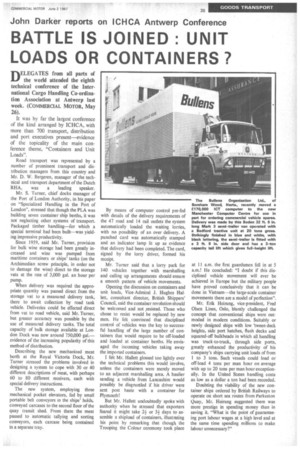BATTLE IS JOINED: UNIT LOADS OR CONTAINERS?
Page 37

If you've noticed an error in this article please click here to report it so we can fix it.
DELEGATES from all parts of the world attended the eighth technical conference of the International Cargo Handling Co-ordination Association at Antwerp last week. (COMMERCIAL MOTOR, May 26).
It was by far the largest conference of the kind arranged by ICHCA, with more than 700 transport, distribution and port executives present—evidence of the topicality of the main conference theme, "Containers and Unit Loads".
Road transport was represented by a number of prominent transport and distribution managers from this country and Mr. D. W. Bergeren, manager of the technical and transport department of the Dutch RHA, was a leading speaker.
Mr. S. Turner, chief docks manager of the Port of London Authority, in his paper on "Specialized Handling in the Port of London', stressed that though the PLA was building seven container ship berths, it was not neglecting other systems of transport. Packaged timber handling—for which a special terminal had been built—was yielding impressive productivity.
Since 1959, said Mr. Turner, provision for bulk wine storage had been greatly increased and wine was pumped from maritime containers or ships' tanks (on the Archimedian screw principle, in order not to damage the wine) direct to the storage vats at the rate of 3,000 gal. an hour per pump.
When delivery was required the appropriate quantity was passed direct from the storage vat to a measured delivery tank, there to await collection by road tank vehicle. Deliveries could be effected direct from vat to road vehicle, said Mr. Turner, but greater accuracy was possible by the use of measured delivery tanks. The total capacity of bulk storage available at London Dock was now around 750,000 gal.— evidence of the increasing popularity of this method of distribution.
Describing the new mechanized meat berth at the Royal Victoria Dock, Mr. Turner stressed the problems involved in designing a system to cope with 30 or 40 different descriptions of meat, with perhaps 60 to 80 different receivers, each with special delivery instructions.
The new system, employing three mechanical pocket elevators, fed by small portable belt conveyors in the ships' holds, conveyed carcases to the second floor of the quay transit shed. From there the meat passed to automatic tallying and sorting conveyors, each carcase being contained in a separate tray. By means of computer control pre-fed with details of the delivery requirements of the 47 road and 14 rail outlets the system automatically loaded the waiting lorries, with no possibility of an over delivery. A punched card was automatically stamped and an indicator lamp lit up as evidence that delivery had been completed. The card, signed by the lorry driver, formed his receipt.
Mr. Turner said that a lorry park for 140 vehicles together with marshalling and calling up arrangements should ensure a smooth pattern of vehicle movements.
Opening the discussion on containers and unit loads, Vice-Admiral J. Hughes Hallett, consultant director, British Shippers' Council, said the container revolution should be welcomed and not yesisted. Those who chose to resist would be replaced by new men. He felt convinced that disciplined control of vehicles was the key to successful handling of the large number of containers that would require to be off-loaded and loaded at container berths. He envisaged the incoming vehicles taking away the imported containers.
I felt Mr. Hallett glossed too lightly over the technical problems this would involve, unless the containers were merely moved to an adjacent marshalling area. A haulier sending a vehicle from Lancashire would possibly be disgruntled if his driver were sent post haste with a container for Plymouth!
But Mr. Hallett undoubtedly spoke with authority when he stressed that exporters feared it might take 2+ or 3+ days to assemble a shipload of containers, illustrating his point by remarking that though the Trooping the Colour ceremony took place at 11 a.m. the first guardsmen fell in at 5 a.m.! He concluded: "I doubt if this disciplined vehicle movement will ever be achieved in Europe but the military people have proved conclusively that it can be done in Vietnam—the large-scale container movements there are a model of perfection".
Mr. Erik Heirung, vice-president, Fred Olsen Lines, Oslo, bluntly challenged the concept that conventional ships were outmoded in modern conditions. Suitably or newly designed ships with low 'tween deck heights, side port hatches, flush decks and squared-off bulkheads in which all handling was truck-to-truck, through side ports, greatly enhanced the productivity of his company's ships carrying unit loads of from 1 to 3 tons. Such vessels could load or off-load 4 tons per man hour on average with up to 20 tons per man hour exceptionally. In the United States handling costs as low as a dollar a ton had been recorded.
Doubting the viability of the new container ships ordered by British Railways to operate on short sea routes from Parkeston Quay, Mr. Heirung suggested there was more prestige in spending money than in saving it. "What is the point of guaranteeing port labour wages at a high level and at the same time spending millions to make labour unnecessary?"




























































































































































